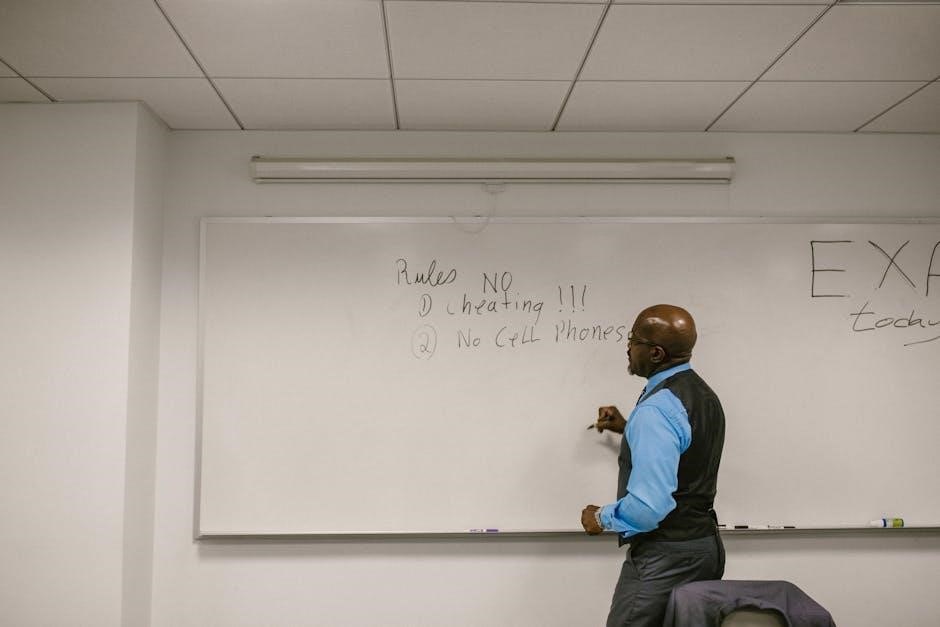rules of divisibility pdf

Divisibility rules are simple methods to determine if a number can be evenly divided by another without performing actual division. A printable PDF chart provides a handy reference for these rules.
Overview of Divisibility Rules
Divisibility rules are straightforward tests used to determine if a number can be evenly divided by another without performing the actual division. These rules vary depending on the divisor and often involve examining specific digits or their sums. For example, a number is divisible by 2 if its last digit is even, while divisibility by 3 is determined by the sum of its digits. Composite numbers like 4, 6, 8, and 9 have their own unique tests, such as checking the last two or three digits for 4 and 8, or summing all digits for 9. Advanced rules, like those for 7 and 11, involve more complex calculations. These rules are widely used in mathematics and real-world applications, making them essential tools for quick mental math and problem-solving. Printable PDF charts are available to help students and educators memorize these rules effectively.
Importance of Divisibility Rules in Mathematics
Divisibility rules hold significant importance in mathematics as they provide quick and efficient methods to determine if a number can be divided evenly by another. These rules are essential for mental math, enabling students to solve problems without resorting to long division. They are particularly useful in real-world scenarios, such as splitting bills evenly or calculating quantities in recipes. Additionally, divisibility rules form the foundation for more advanced mathematical concepts, like number theory and modular arithmetic. Educators often emphasize these rules to improve numerical fluency and problem-solving skills. Printable PDF charts are widely used as reference tools, helping learners of all ages to master and apply these rules effectively in various mathematical contexts.

Fundamental Divisibility Rules

These rules are foundational for checking divisibility by smaller numbers like 2, 3, 5, and 10. They involve examining the last digit or sum of digits for quick verification.
Rule for 2

The rule for 2 is straightforward: a number is divisible by 2 if its last digit is even. This means the number ends in 0, 2, 4, 6, or 8. For example, 48 is divisible by 2 because it ends in 8, which is an even digit. Similarly, 123,456 is divisible by 2 because it ends in 6. This rule is one of the simplest and quickest ways to check divisibility, making it a foundational tool for mental math and initial number checks. It is particularly useful for identifying even numbers at a glance, which is essential in various mathematical operations and everyday calculations. This rule is also a starting point for more complex divisibility checks for larger numbers.

Rule for 3
The rule for 3 states that a number is divisible by 3 if the sum of its digits is a multiple of 3. For example, in the number 96, the sum of the digits is 9 + 6 = 15, which is divisible by 3. Therefore, 96 is divisible by 3. Similarly, for the number 333, the sum of the digits is 3 + 3 + 3 = 9, which is also divisible by 3. This rule is especially useful for larger numbers, as it simplifies the process of checking divisibility without performing actual division. The sum of digits method is a cornerstone of many divisibility tests and is widely taught in mathematics education. It provides a quick and reliable way to determine divisibility by 3 in various mathematical problems and real-world applications.
Rule for 5
The rule for 5 is straightforward: a number is divisible by 5 if its last digit is either 0 or 5. This applies to all whole numbers. For example, 1000 is divisible by 5 because it ends in 0, and 537 is divisible by 5 because it ends in 5. This rule is highly reliable and easy to apply, making it one of the most commonly used divisibility tests. It is especially useful for quick checks without performing actual division. The simplicity of this rule makes it a foundational concept in mathematics education, often taught early in a student’s learning journey. Additionally, this rule is included in many downloadable PDF charts and resources for easy reference and practice.
Rule for 10
The rule for 10 is simple and quick: a number is divisible by 10 if its last digit is 0. This means any number ending in 0 can be evenly divided by 10 without a remainder. For example, 90, 100, and 500 are all divisible by 10. This rule is universally applicable and is often one of the first divisibility rules taught to students. Its simplicity makes it a foundational tool in arithmetic operations. Many educational resources, including downloadable PDF charts, emphasize this rule for its ease of use and reliability. It is particularly useful for identifying multiples of 10 at a glance, enhancing efficiency in mathematical problem-solving.
Divisibility Rules for Composite Numbers
Composite numbers like 4, 6, 8, and 9 have specific divisibility rules that combine basic principles. These rules often involve checking the last few digits or digit sums, providing efficient divisibility tests.
Rule for 4
The rule for 4 states that a number is divisible by 4 if the number formed by its last two digits is divisible by 4. For example, in the number 124, the last two digits form 24, which is divisible by 4. Therefore, 124 is divisible by 4. This rule works because 100 is divisible by 4, so the hundreds place and beyond do not affect divisibility by 4. Simply focus on the last two digits to apply this rule. If the last two digits form a number that is divisible by 4, the entire number is also divisible by 4. This method provides a quick and efficient way to check divisibility without performing long division.
Rule for 8
The rule for 8 involves examining the last three digits of a number to determine if it is divisible by 8. For instance, in the number 2673480, the last three digits are 480. Since 480 divided by 8 equals 60, which is a whole number, 2673480 is divisible by 8. This rule is effective because 1000 is divisible by 8, making the digits beyond the last three irrelevant. If the number formed by the last three digits is divisible by 8, the entire number is also divisible by 8. This method is particularly useful for larger numbers, as it simplifies the divisibility check to just three digits. It is a quick and reliable technique for verifying divisibility by 8 without complex calculations.
Rule for 6
A number is divisible by 6 if it meets two criteria: it must be divisible by both 2 and 3. To apply this rule, first check if the number is even (divisible by 2) by ensuring its last digit is 0, 2, 4, 6, or 8. Next, verify if the sum of its digits is a multiple of 3. For example, the number 72 is divisible by 6 because it is even (last digit is 2) and the sum of its digits (7 + 2 = 9) is divisible by 3. This combined rule simplifies checking divisibility by 6 without performing division, making it a practical tool for quick mental math or classroom exercises. It is widely used in educational settings to help students master divisibility concepts effectively.
Rule for 9

The rule for 9 states that a number is divisible by 9 if the sum of its digits is a multiple of 9. For example, the number 14526 is divisible by 9 because the sum of its digits (1 + 4 + 5 + 2 + 6 = 18) is divisible by 9. This rule is particularly useful for checking divisibility without performing lengthy calculations. It is commonly taught in schools and is included in downloadable PDF charts as a quick reference tool for students and educators. This method ensures accuracy and efficiency, making it a valuable skill in both academic and real-world applications of mathematics.

Advanced Divisibility Rules
Advanced divisibility rules include methods for 7 and 11, often requiring multiple steps. For example, the rule for 12 combines the rules for 3 and 4, enhancing efficiency.
Rule for 7
The divisibility rule for 7 involves a two-step process. Take the last digit of the number, double it, and subtract this value from the rest of the number. If the result is a multiple of 7, the original number is divisible by 7. For example, to check if 161 is divisible by 7:
Take the last digit (1), double it to get 2.
Subtract this from the remaining number: 16 ー 2 = 14.
Since 14 is divisible by 7, 161 is also divisible by 7. This method can be repeated if the result is still large. It’s a handy technique for checking divisibility without performing long division.
Rule for 11
The divisibility rule for 11 is based on the difference between the sum of the digits in the odd positions and the sum of the digits in the even positions. For example, in the number 121:
Sum of odd-position digits: 1 (first digit) + 1 (third digit) = 2.
Sum of even-position digits: 2 (second digit) = 2.
Subtract the two sums: 2 ⏤ 2 = 0.
Since the result is 0, which is divisible by 11, the number 121 is also divisible by 11. This rule works for all numbers, regardless of their length, making it a flexible and efficient method to check divisibility by 11 without actual division.
Combining Divisibility Rules for Larger Numbers
Combining divisibility rules allows you to check larger numbers by leveraging multiple rules at once. For example, to determine if a number is divisible by 6, check if it is divisible by both 2 and 3. Similarly, for 12, ensure the number is divisible by 3 and 4. This method simplifies checking divisibility for composite numbers like 6, 12, and 24. For instance, to verify if 144 is divisible by 12, confirm it is divisible by both 3 (sum of digits is 9, which is divisible by 3) and 4 (last two digits, 44, are divisible by 4); This approach avoids complex calculations and makes divisibility checks more efficient for larger numbers.

Exceptions and Limitations of Divisibility Rules
While divisibility rules are highly useful, they have certain exceptions and limitations. For instance, the rule for 7 is more complex and requires repetitive steps, making it less straightforward than others. Additionally, some rules, like those for 8 and 9, rely on specific digit patterns, which may not always guarantee accuracy for very large numbers. Certain rules, such as the one for 1, are inherently trivial since any number is divisible by 1. Furthermore, some rules only apply to base-10 number systems, limiting their versatility. These exceptions highlight that while divisibility rules are powerful tools, they are best used as initial checks rather than definitive proofs of divisibility in all cases.

Practical Applications of Divisibility Rules
Divisibility rules offer numerous practical applications across various fields. In education, they serve as essential tools for teaching students foundational math concepts, enabling quick mental calculations and enhancing problem-solving skills. Professionals, such as accountants and data analysts, utilize these rules to verify financial calculations and detect errors efficiently. Additionally, programmers incorporate divisibility rules into algorithms for tasks like validating credit card numbers or checking data formats. These rules also simplify everyday tasks, such as splitting bills evenly or checking if a number fits specific patterns. Overall, divisibility rules provide a practical and efficient way to handle numerical tasks without relying on calculators or extensive computations, making them invaluable in both academic and real-world scenarios.
Downloadable Divisibility Rules Chart in PDF
A downloadable PDF chart of divisibility rules is an excellent resource for students and educators. It provides a concise, visually organized reference guide for rules of numbers 2 through 10. The chart is printable and can be easily shared or displayed in classrooms. Many websites offer editable versions in Microsoft Publisher, allowing customization to suit specific teaching needs. Additionally, the PDF format ensures compatibility across devices, making it accessible for digital use. This chart is particularly useful for reinforcing math concepts and serving as a quick reference during exams or homework. Its availability online makes it a convenient tool for anyone seeking to master or teach divisibility rules effectively.
Divisibility rules offer a practical and efficient way to determine if a number can be evenly divided by another without performing complex calculations. These rules, ranging from simple checks for 2, 3, and 5 to more complex tests for 7 and 11, are invaluable for mental math and quick problem-solving. By mastering these rules, students and professionals alike can streamline their mathematical processes. Additionally, resources like printable PDF charts provide a convenient way to reference and teach these rules. Whether for classroom learning or real-world applications, divisibility rules remain an essential tool in mathematics, enhancing understanding and problem-solving skills across all levels.